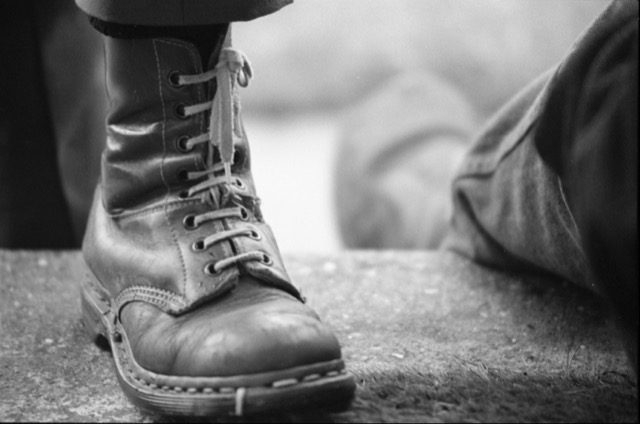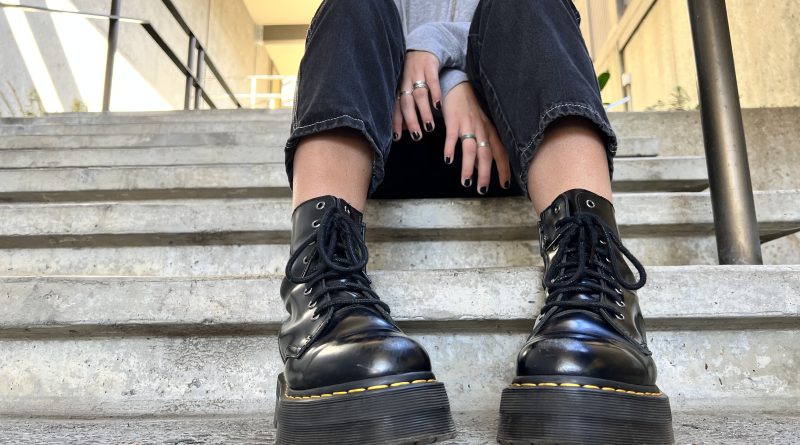The controversial history of Dr. Martens
Stomping through rain, snow or shine, Dr. Martens guard your feet like armor with their vintage style leather and chunky rubber soles. After nearly 75 years, the shoe continues to carry its weight. This time, in the closets of Gen Z.
“I think they’re kind of like a timeless classic,” said Angela Schumard, a freshman majoring in sociology at Cal Poly Humboldt. “Like who doesn’t love a nice pair of solid boots?”

But how can something so obsolete as a shoe become so politically-charged? Well, here’s what you probably didn’t know about your favorite shoe.
Invented in 1945 in Seeshaupt, Germany by Dr. Klaus Maertens, a 25-year-old Nazi soldier, the shoe was designed with the intention to help aid Dr. Maerten’s recovery after a broken foot. Using military supplies to produce the shoe, Dr. Maertens and his friend, Dr. Herbert Funk, went into business selling the shoe mainly to older women.
An English company bought the license for Dr. Maerten’s air-cushioned sole in 1960 and after making a few changes, the iconic eight-holed 1460 boot was born. The boot was built for comfort and durability. The 1460 boot began by uniforming police, postmen and factory workers in the U.K.
Doctor Catherine Davies, a senior lecturer in visual culture at Cardiff Metropolitan University and author of “Smells like Teen Spirit: Channeling subcultural traditions in contemporary Dr. Martens branding” said, “In the late 60’s and 70’s in the U.K., these types of boots that were associated with postal workers, police officers, were claimed as street style by subcultural tribes such as punks and goths, and the skinheads.”
Dr. Davies went on to state, “It’s important to know they were an anti-fashion statement by subcultural tribes and they were modified and customized accordingly.”
The punks graffitied their docs, the skinheads customized their laces and the goths painted the yellow bits black.

At the time, Dr. Davies, who has done much research on the history of the brand and their advertising tactics, noted that all of this was happening independent of the brand itself and the brand was not happy being known for these associations.
“There was a small contingent of the subculture [of skinheads] that were racist, that were part of the national front,” Dr. Davies said. “Any form of youth expression has a uniform. Therefore, there was a sense that Dr. Martens were metonymic or stood for these particular, problematic attitudes.”
According to Dr. Davies, though, not all skinheads were racist or violent and the spread of this narrative was mainly a portrayal by the British media of alternative groups being problematic.
Growing up in the 80’s herself, Dr. Davies recalled how as a teenager you weren’t allowed to wear them to school because of their associations with violence.
Often football stadiums would ask guests to take off their Dr. Martens before entering the stadium as many of them had steel-toe caps. “They were literally a weapon,” Dr. Davies said.
When asked how she feels about the controversial history of the brand in association to skinheads, Schumard said, “Doc Martens are a little bit more edgy in style I feel so it definitely ties in with that kind of culture they were based off of and used for. But I don’t know if I see that resonating today at all, which is good, but the fact it did exist at one point is very concerning.”
Reconfiguring the associations of the past, Dr. Martens has now utilized its historical ties to British youth subcultures to sell modern-day consumers a sense of vintage individuality.
“You buy rebellion with these boots now,” Dr. Davies said.




